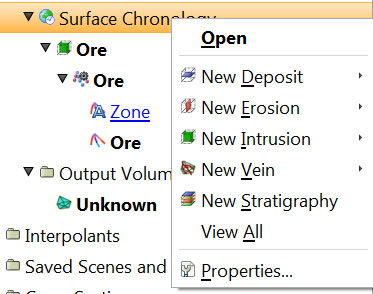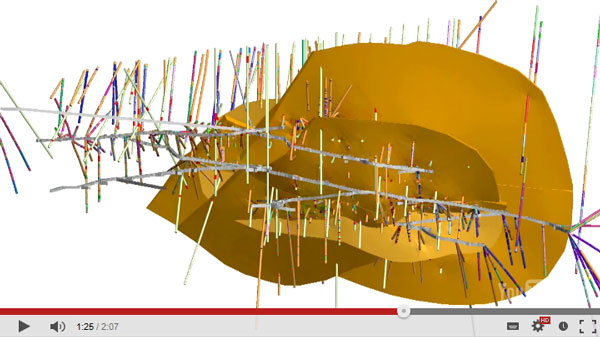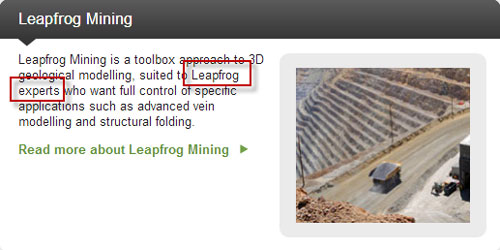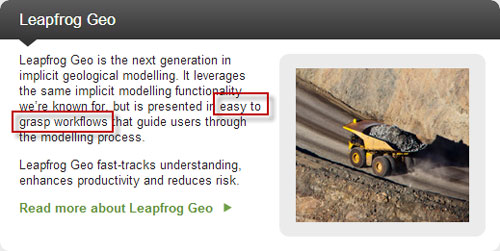ARANZ Geo released Leapfrog Geo software on 25 February 2013. They claim that Leapfrog Geo ‘fast tracks understanding, enhances productivity and reduces risk’ (Figure 1). Orefind will test these claims in a follow-up post, but for the moment, here are our first impressions of this newly released software.

Figure 1. A proclamation of very vague things Leapfrog Geo can do, but I’m more interested in what it cannot do.
Leapfrog Geo will not open Leapfrog Mining projects!
This is not a typo. Let me repeat it: Leapfrog Geo will not open Leapfrog Mining projects!
That's
one clear reason why you should stick with Leapfrog Mining if you are already an expert at building geological models.
What about the other 1000 reasons?
As at March 2013, I estimate that there are between 700 and 1000 active licences of Leapfrog Mining in use around the world. These active users may have up to twenty Leapfrog Mining projects each; personally, I have over 600 projects created in Leapfrog Mining.
So, conservatively, there are more than 1000 Leapfrog Mining projects in existence that geologists have built.
Not one of these Leapfrog Mining projects can be opened with Leapfrog Geo.
If you decide to switch to Leapfrog Geo (as ARANZ Geo is encouraging you to do), your existing Leapfrog Mining projects have to be ‘converted’ to Leapfrog Geo format. I've put ‘converted’ in quotation marks as there appears to be no automated way of converting your projects. You either have to do this ‘conversion’ manually (i.e. you rebuild the entire project), or you have to pay ARANZ Geo to do it for you.
I contacted a Leapfrog sales rep and asked if ARANZ Geo will be footing the price for project ‘conversions’. The sales rep was understandably noncommittal.
Effectively, this means that approximately 1000 licence holders of Leapfrog Mining, each of whom has multiple projects built over the past decade, will not be able to open their old projects with Leapfrog Geo, without performing a manual ‘conversion’ process on each project at their own cost. That’s many thousands of projects.
If a software company is willing to risk their business and their existing client base by suddenly introducing a completely new software application (Leapfrog Geo) for their clients to switch to from the tried and tested software (Leapfrog Mining), then this new software must be FULL of fantastic innovations, right?
Well, let’s open the hood and take a closer look…
‘Innovation’ really means GUI rearrangement
It seems to me that Leapfrog Geo, ARANZ Geo’s latest ‘innovation’, is actually a graphical user interface (GUI) repackaging of Leapfrog Mining, with a few additional workflow features that aren't present in Leapfrog Mining—and without a whole lot of features currently available in Leapfrog Mining. I am yet to find any ground-breaking innovations that equal Leapfrog Mining’s fast grade interpolation (based on Fast RBF), its 3D drawing tool, its structural trends using localised interpolation, or its structural form interpolator.
As far as I can see, the most compelling feature of Leapfrog Geo is the ability to rapidly subdivide the project volume into faulted blocks (as an aside,
GeoModeller has been doing this for more than a decade), but apart from this I struggle to see any benefits. Geological chronology is something that is now formalised in Leapfrog Geo, but I’ve been using and teaching chronology-based modelling methods in Leapfrog Mining for many years. The recent Leapfrog Mining improvements to the domains area mean that consideration of relative geological chronology is really simple and very fast. In fact, if you know the basic building blocks of Leapfrog Mining, virtually everything Leapfrog Geo can do in this area, and more, can be done with Leapfrog Mining.
In contrast, the language used in Leapfrog Geo can be very confusing. Contrary to the claims that this new software works on terminology that is familiar to geologists, let’s look at an example. What do you think the word ‘deposit’ means and in what context would you expect it to be used in the minerals industry? ‘New Deposit’ is one of the options in the surface chronology drop-down list; however, it does not equate to ‘mineral deposit’, but to a ‘sedimentary depositional unit’ (Figure 2).
 Figure 2. Leapfrog Geo talks about ‘surface chronology’ rather than relative chronology of geological units or volumes. Also ‘New Deposit’ shown here does not mean what you think it means! None of this unnecessary terminological confusion exists in Leapfrog Mining.
Figure 2. Leapfrog Geo talks about ‘surface chronology’ rather than relative chronology of geological units or volumes. Also ‘New Deposit’ shown here does not mean what you think it means! None of this unnecessary terminological confusion exists in Leapfrog Mining.
If you delve into the details ‘New Deposit’ is actually referring to the basal surface of this deposition unit! That’s completely unintuitive for software that’s meant to be used by the minerals industry that rarely ever has any record of layer-cake stratigraphy. Perhaps we are meant to unravel the stratigraphic order of rock packages that have been folded multiple times first to make sense of this software? Has this software has been designed by people who looked up terms in a geological dictionary, but who didn’t know the relevance of these terms to industry practice?
Much of the ‘innovative’ geological chronology feature in Leapfrog Geo looks to me very like the tools in
GeoModeller, who invented this approach in the 1990s as its predecessor Web Editeur Géologique or 3DWEG. Even the stratigraphic model outputs that ARANZ Geo uses in their marketing material appear very similar to GeoModeller’s (Figure 3).
 Figure 3. GeoModeller or Leapfrog Geo?
Figure 3. GeoModeller or Leapfrog Geo?
In terms of features, there appear to be fewer features in Leapfrog Geo compared to those in Leapfrog Mining. One very experienced Leapfrog Mining user who has also tested this new software described it this way: ’…Leapfrog Geo appears to have removed up to 50% of Leapfrog Mining's functionality’. This sentiment is confirmed by looking through the
Leapfrog Mining FAQ (Figure 4), although these missing features are interestingly not listed in the
Leapfrog Geo FAQ so their new customers remain uninformed. Strangely though the vein modelling tool that is listed as missing appears in the
Leapfrog Geo promotional video, which is really confusing (Figure 5).
Not completely replicating Leapfrog Mining’s features in Leapfrog Geo for a release version is an interesting decision on the part of ARANZ Geo, especially as the price of Leapfrog Geo is the same as Leapfrog Mining! You pay the same but get 50% fewer features? That just doesn't add up to me.
 Figure 4. These are the missing features from Leapfrog Geo which are all available in Leapfrog Mining according to Leapfrog Mining FAQ. Vein modelling is not possible, so sites that depend on this tool, such as Boddington, will be sticking to Leapfrog Mining.
Figure 4. These are the missing features from Leapfrog Geo which are all available in Leapfrog Mining according to Leapfrog Mining FAQ. Vein modelling is not possible, so sites that depend on this tool, such as Boddington, will be sticking to Leapfrog Mining.
 Figure 5. These sheet-like models which very much appears to have been created with the ‘vein modelling tool’ of Leapfrog Mining appears in the main promotional video of Leapfrog Geo. A little confusing as this tool is listed as being missing from Leapfrog Geo in the Leapfrog Geo FAQ (Figure 4).
Figure 5. These sheet-like models which very much appears to have been created with the ‘vein modelling tool’ of Leapfrog Mining appears in the main promotional video of Leapfrog Geo. A little confusing as this tool is listed as being missing from Leapfrog Geo in the Leapfrog Geo FAQ (Figure 4). The real risk – the illusion of bug-free perfect software
Leapfrog Mining has been tested in the field and has evolved over nearly a decade; as it is new software, I can confidently assume that Leapfrog Geo has not been tested with the same rigor or as exhaustively. Thus there is an unknown risk for any company considering switching to this new software, particularly if they are building models for resource evaluation purposes. Some of these are very complex models built over several months or years, with a significant investment of time and knowledge.
ARANZ Geo is encouraging companies to switch to this new software. This is despite the fact that these projects will have to be rebuilt (by the user) from scratch using software that has not been proven. Switching to newer, untested software does not reduce risk, but increases it for the end user of Leapfrog. What’s more, that unquantified risk won’t be borne by ARANZ Geo, but by your company, and your time.
As the conceptual founder of Leapfrog software (now called Leapfrog Mining), I played a fundamental role in its design, but I had no part in designing Leapfrog Geo. I know a few things about software development and I know that the development of bug-free software simply does not occur overnight. In the case of Leapfrog Mining, the process of perfection and evolution took more than a decade and only happened because I worked closely with a very good listener—Dr Hughan Ross—who was Leapfrog’s Chief Software Architect in the early years. And then there were the countless individuals who provided enhancement suggestions and feedback about bugs. These people were effectively beta testers of new versions and as such were integral to Leapfrog Mining’s success. I doubt that Leapfrog Mining in its current form could have been developed without this close working partnership between Zaparo staff and the many geologists who provided useful feedback.
Unless ARANZ Geo bears the responsibility for risks associated with buggy software, I think their comment about ‘reducing risk’ will have to be taken with a large grain of salt. I can guarantee that there will be bugs (all software has bugs), possibly some serious ones. Since Leapfrog Geo’s GUI is so different from Leapfrog Mining’s, issues that were dealt with years ago in Leapfrog Mining may resurface. There will likely be a lot of bug-fixing, patches, new releases etc. for many years to come, all of which can negatively impact the customer’s ability to run their business. Is that ‘reducing risk’?
Leapfrog for Dummies?
With ARANZ Geo pushing Leapfrog Geo so eagerly to new users, or those who aren’t ‘Leapfrog experts’ (Figures 6 and 7), I expect that new customers will purchase the workflow-based Leapfrog Geo over its more full-featured cousin Leapfrog Mining —or turn to a competitor who makes consistently up-gradable software.
After all, why bother learning how to use an espresso machine when you can use a pod coffee machine? No mess, no pain, and you get the same consistent—and terrible—result every time! Personally, I wouldn’t fork out for a pod coffee machine if an espresso machine was available for the same price. Likewise with software—I would rather get the full version and get competent training from geologists who have years of experience modelling real data with Leapfrog Mining.
 Figure 6. Leapfrog Mining is stated as being suitable for “Leapfrog experts” according to the Leapfrog3d.com website.
Figure 6. Leapfrog Mining is stated as being suitable for “Leapfrog experts” according to the Leapfrog3d.com website.  Figure 7. In contrast, the word ‘expert’ is missing from Leapfrog Geo’s description, and instead the workflows are described as ‘easy to grasp’. Perhaps this software is for Leapfrog Dummies?
Figure 7. In contrast, the word ‘expert’ is missing from Leapfrog Geo’s description, and instead the workflows are described as ‘easy to grasp’. Perhaps this software is for Leapfrog Dummies?
The sad thing is that those new Leapfrog Geo users will never know what Leapfrog Mining could have done for them.
In the next post to follow on this topic, I’ll talk about some fabulous features in Leapfrog Mining that are completely missing from Leapfrog Geo.